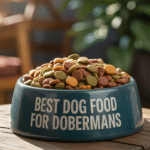Many pet owners wonder, “Can dogs eat pineapple?” The good news is that pineapple can be a safe, nutritious snack for your furry friend when offered in moderation. This tropical fruit is packed with vitamins and minerals that can support your dog’s health. However, there are some precautions to consider. Let’s explore both the health benefits and potential risks of feeding pineapple to dogs.
Health Benefits of Pineapple for Dogs
Pineapple is a nutrient-rich fruit that offers several health benefits for dogs. Here’s what makes it a good treat:
- Rich in Vitamins: Pineapple contains vitamins A, B6, and C, which can support your dog’s immune system and skin health.
- High in Fiber: The fiber in pineapple can aid digestion, helping to prevent issues like constipation.
- Antioxidant Properties: Pineapple is packed with antioxidants, which can help reduce inflammation and support overall health in your dog.
- Hydration: Since pineapple has high water content, it can help keep your dog hydrated.
- Low in calories: This fruit is low in calories, making it a great option for snacks, especially for dogs that need to maintain a healthy weight.
Risks of Feeding Pineapple to Dogs
While pineapple has several benefits, there are also some risks to keep in mind:
- High Sugar Content: Pineapple contains natural sugars, which can be problematic for dogs that are overweight or have diabetes. Moderation is key.
- Possible Allergies: Some dogs may develop an allergic reaction to pineapple. Watch for signs like itching or upset stomach.
- Unripe Pineapple: Do not feed dogs unripe pineapple, as it may lead to digestive upset.
- Choking Hazard: Always remove the outer skin and core before giving pineapple to your dog, as these parts can pose a choking risk.
How to Safely Feed Pineapple to Your Dog
If you decide to share pineapple with your dog, here are some tips for doing it safely:
- Start with small pieces to see how your dog reacts.
- Always remove the skin and core; only provide the soft, fleshy part.
- Consider fresh pineapple rather than canned pineapple, as canned varieties often contain added sugar and preservatives.
- Limit pineapple to a small treat occasionally, as it should not replace a balanced diet.
How Much Pineapple Can Dogs Eat?
The amount of pineapple you can safely give your dog can vary based on size. Here is a guideline:
| Dog Size | Pineapple Serving Size |
|---|---|
| Small Dogs (under 20 lbs) | 1-2 small chunks |
| Medium Dogs (20-50 lbs) | 2-3 chunks |
| Large Dogs (50+ lbs) | 3-4 chunks |
Final Thoughts
Pineapple can be a delicious and nutritious treat for your dog when given in moderation. Remember to watch for any adverse reactions and consult your veterinarian before introducing new foods. If you’re looking for more information, you can visit AKC or PetMD for further guidance.
Now that you know the benefits and risks, you can make an informed decision on whether to share this tasty fruit with your furry companion!
Safe Methods to Introduce Pineapple into Your Dog’s Diet
Pineapple is a delicious treat that many people enjoy, and it can be a fun addition to your dog’s diet in moderation. However, before you toss a piece of pineapple to your fuzzy friend, there are important considerations to ensure that it is safe and beneficial for your pet. Below, we explore safe methods to introduce pineapple into your dog’s diet.
Understanding Pineapple’s Nutritional Benefits
Pineapple is packed with nutrients that can be beneficial for dogs, including:
- Vitamins: Pineapple is rich in vitamin C, which can help support your dog’s immune system.
- Manganese: This mineral is essential for bone health and metabolism.
- Bromelain: An enzyme that may aid digestion and reduce inflammation.
Choosing Fresh Pineapple
When introducing pineapple to your dog, always choose fresh fruit. Canned pineapple often contains added sugars and preservatives that are not healthy for your dog. Make sure to remove the tough outer skin and the core, as these parts can be difficult for your dog to digest.
Start Small
Just like with any new food, it’s crucial to start with small amounts. This helps you monitor your dog’s reaction and digestion. You might want to begin with just a small bite of pineapple, observing your dog for any adverse reactions.
Steps to Introduce Pineapple
- Begin with a small piece of fresh pineapple.
- Observe your dog’s behavior and digestion over the next 24 hours.
- If your dog shows no signs of upset stomach or allergic reaction, you can gradually increase the amount.
Serving Suggestions
There are fun and enjoyable ways to serve pineapple to your dog:
- Frozen Treats: Cut fresh pineapple into small cubes and freeze them. Dogs love these refreshing snacks on warm days.
- Pineapple Smoothies: Blend a small amount of pineapple with some yogurt (make sure it’s dog-friendly) for a tasty treat.
- Mixed into Food: Chop pineapple into tiny pieces and mix it with your dog’s regular food for a nutritious boost.
Watch for Allergic Reactions
Even though pineapple is generally safe for dogs, some may be sensitive or allergic. Signs of an allergic reaction can include:
- Itching or rashes
- Vomiting or diarrhea
- Swelling of the face or paws
If you notice any of these symptoms, consult your veterinarian immediately.
Consult with Your Vet
Before making any significant changes to your dog’s diet, it’s wise to consult with your veterinarian. They can provide guidance on how much pineapple is appropriate based on your dog’s size, breed, and dietary needs.
Portion Control is Key
While pineapple is healthy, it contains natural sugars. It’s best to limit the amount you give to your dog. A good rule of thumb is that treats, including fruit like pineapple, should not account for more than 10% of your dog’s daily caloric intake. Here’s a simple table to illustrate portion sizes:
| Dog Size | Recommended Pineapple Serving |
|---|---|
| Small Dogs (under 20 lbs) | 1-2 small pieces |
| Medium Dogs (20-50 lbs) | 2-4 small pieces |
| Large Dogs (51 lbs and up) | 4-6 small pieces |
Explore More Resources
If you want to learn more about dog-friendly fruits and healthy snacks, check out this article from the AKC. It’s a great resource for pet owners seeking to improve their dog’s nutrition.
For additional expert advice on what’s safe for your dog, consider visiting the ASPCA’s resource page.
By following these guidelines, you can safely introduce pineapple into your dog’s diet, allowing them to enjoy this tasty fruit while reaping the health benefits. Remember, moderation is essential in any dietary changes to keep your furry friend happy and healthy!
Nutritional Value of Pineapple for Dogs
Pineapple is a vibrant tropical fruit that many people enjoy, but have you ever wondered whether your furry friend can eat pineapple too? The nutritional benefits of pineapple for dogs are fascinating and worth exploring. Let’s dive into the specifics of this juicy fruit, its health benefits for dogs, and how you can safely incorporate it into their diet.
Health Benefits of Pineapple for Dogs
Pineapple is not just sweet and delicious; it’s packed with vitamins and minerals that can be beneficial for your canine companion. Here are some of the key nutritional aspects:
- Vitamins: Pineapple is rich in Vitamin C, which is important for your dog’s immune system. It also contains Vitamin B6, essential for energy metabolism.
- Minerals: This fruit includes manganese, which helps with bone formation and metabolism. It also has small amounts of potassium, aiding in proper muscle function.
- Digestive Health: Pineapple contains bromelain, an enzyme that can aid in digestion and reduce inflammation. This can be particularly useful for dogs experiencing digestive issues.
- Hydration: With its high water content, pineapple can help keep your dog hydrated, especially during hot weather.
Caloric Content of Pineapple
When considering whether to feed your dog pineapple, it’s important to pay attention to the caloric content. A suitable serving size and understanding the calorie count can ensure your pup maintains a healthy weight. Below is a table displaying the approximate caloric content of pineapple:
| Serving Size | Calories |
|---|---|
| 1 slice (about 56g) | 28 Calories |
| ½ cup (about 77g) | 41 Calories |
| 1 cup (about 165g) | 82 Calories |
Remember, moderation is key. While pineapple can be a nutritious snack for dogs, it should not make up more than 10% of their daily caloric intake.
How to Safely Feed Pineapple to Your Dog
When introducing any new treat into your dog’s diet, it’s crucial to do so safely. Here are some tips on how to incorporate pineapple into your dog’s meals or snacks:
- Fresh Pineapple: Always use fresh pineapple instead of canned. Canned varieties often contain added sugars and preservatives that can harm your dog.
- Remove the Core & Skin: Never feed your dog the tough outer skin or the core of the pineapple as they can cause choking or digestive blockages.
- Small Portions: Start with small pieces to see how your dog reacts. Cut the pineapple into bite-sized chunks for easier consumption.
- Frozen Treats: For a refreshing summer snack, try freezing small pieces of pineapple. Your dog will love the cold treat!
Potential Risks of Feeding Pineapple to Dogs
While pineapple can be beneficial, it’s also essential to be aware of potential risks:
- Digestive Upset: Feeding too much pineapple can lead to stomach upset in dogs. Signs may include vomiting or diarrhea.
- Allergic Reactions: Some dogs may be allergic to new foods. Monitor your dog for any signs of an allergic reaction after introducing pineapple.
- Sugar Content: Pineapple is high in sugar, which can be detrimental for dogs with diabetes or obesity.
Pineapple Recipes for Dogs
If you’re looking to get creative, here are a couple of simple pineapple recipes that your dog might enjoy:
- Pineapple Pupsicles: Blend fresh pineapple with yogurt and water, pour into ice cube trays, and freeze. Perfect for a hot day!
- Pineapple and Chicken Treats: Mix small amounts of pineapple puree with cooked chicken, then bake for tasty biscuits your dog will love.
Pineapple into your dog’s diet can be a fun and healthy way to treat them. Just remember to proceed with caution and moderation. For more details about dog nutrition and safe fruits, you might find this article from the American Kennel Club informative.
With proper considerations, you can ensure your dog enjoys the delightful taste of pineapple, while reaping its nutritional benefits. Happy feeding!
Alternatives to Pineapple for a Healthy Dog Treat
When it comes to treating your furry friend, you want to ensure you’re giving them the best, healthiest options. While pineapple is a popular treat for dogs due to its sweetness and nutritional benefits, not all dogs may enjoy it or digest it well. Luckily, there are many alternatives that can provide similar health benefits without the risk. Below are some great substitutes for pineapple that can make tasty and nutritious dog treats.
Fruits That Are Safe for Your Dog
Fruits are excellent choices for dog treats, as they offer vitamins, minerals, and antioxidants. Here are some dog-friendly fruits you can consider:
- Blueberries: Full of antioxidants, these small berries can help combat oxidative stress.
- Watermelon: Refreshing and hydrating, watermelon is a low-calorie treat. Just be sure to remove the seeds and rind.
- Apples: Apples are a great source of vitamins A and C, plus fiber. Always remove the seeds and core.
- Bananas: Rich in potassium, bananas can be a great occasional treat, but they should be given in moderation due to their sugar content.
- Carrots: Though not a fruit, carrots are crunchy and make for a low-calorie dog snack packed with beta-carotene.
Nutritious Vegetables for Your Pet
If you’re looking to give your dog something crunchy and healthy, vegetables can be a fantastic alternative. Here are some safe options:
- Green beans: A great source of vitamins and low in calories. Dogs usually enjoy the crunchy texture.
- Sweet potatoes: Rich in vitamins A, C, and B6, sweet potatoes can be cooked and served mashed or as treats.
- Peas: Green peas can provide protein, fiber, and a host of vitamins for your dog’s health.
Homemade Treat Recipes
You may also want to try creating your own healthy dog treats. Here’s a simple recipe that uses pumpkin, which is great for dogs:
Pumpkin Dog Treats
Ingredients:
- 1 cup of pure pumpkin puree
- 2 cups of whole wheat flour (or alternative if your dog is gluten-sensitive)
- 1 egg
- 1/4 cup of oats
- 1/2 teaspoon of cinnamon (optional)
Instructions:
- Preheat your oven to 350°F (175°C).
- Mix all ingredients in a bowl until well combined.
- Roll out the dough and cut it into shapes.
- Bake for about 30 minutes or until golden brown.
- Let cool before serving to your dog.
This recipe provides a nutritious and delicious alternative that your pet will love.
Store-Bought Treats
If you prefer not to bake, many commercial dog treats use healthy ingredients similar to pineapple and provide great nutritional benefits. Look for options that are made with:
- Real meat or fish as the primary ingredient.
- Whole grains like oats or brown rice.
- Fruits and vegetables, like blueberries or carrots.
Always read the labels to ensure the treats are free from harmful additives and preservatives.
Important Considerations
When introducing any new foods or treats into your dog’s diet, start small. Monitor your pet for any signs of allergic reaction or digestive issues. As every dog is unique, what works for one may not work for another.
For more information on healthy dog treats, you can visit the American Kennel Club or Preventive Vet to get expert advice and tips.
Providing your dog with a variety of tasty and nutritious treats can keep snacking fun and healthy. Remember, treats should only make up a small part of your dog’s diet while ensuring they remain balanced and healthy overall.
Signs Your Dog May Be Allergic to Pineapple
Pineapple is a delicious tropical fruit that many people enjoy, and it’s common for dog owners to wonder if their furry friends can share in the fruity goodness. While pineapple is generally safe for dogs in small amounts, some dogs might be allergic or sensitive to it. Knowing the signs that your dog may be allergic to pineapple is crucial for their health and well-being.
Common Allergic Reactions
If your dog has consumed pineapple and shows signs of an allergic reaction, being alert to these symptoms will help you act quickly. Common signs to watch for include:
- Itchy Skin: If your dog starts scratching more than usual or shows signs of irritation, it may indicate an allergy.
- Red and Infected Skin: Allergies can cause redness or inflammation. Check if your dog has any rashes or hot spots.
- Digestive Issues: Vomiting or diarrhea shortly after eating pineapple could signal a sensitivity or allergy.
- Ear Infections: Dogs with allergies often develop chronic ear infections. If you notice a foul smell or discharge from your dog’s ears, it could be a sign.
- Facial Swelling: Swelling around the eyes, muzzle, or face is a serious sign and warrants immediate vet consultation.
Behavioral Changes
In addition to physical symptoms, you might observe behavioral changes that could suggest an allergic reaction to pineapple or any new food. These might include:
- Increased Agitation: If your dog seems more restless than usual, it could be a reaction to discomfort.
- Reduction in Activity: A sudden drop in energy might indicate that your dog is not feeling well.
- Loss of Appetite: If your dog refuses to eat or seems disinterested in food after consuming pineapple, it may be reacting adversely.
Monitoring Your Dog
After giving your dog pineapple for the first time, keep a close eye on them for at least 24 hours. It’s smart to introduce any new food gradually to minimize the risk of allergies. Start with just a small piece, and observe their reactions. Monitor for any symptoms mentioned above, which could indicate an adverse reaction.
What to Do if You Suspect an Allergy
If you notice any signs of an allergy after your dog has eaten pineapple, take the following steps:
- Stop Feeding Pineapple: Immediately remove it from their diet to prevent further reactions.
- Contact Your Vet: If symptoms are severe or persist, consulting your veterinarian is essential. They may recommend an allergy test.
- Document Symptoms: Keep a record of your dog’s symptoms, including when they occurred and the amount of pineapple consumed. This information can help your vet diagnose the issue more effectively.
- Consider Alternatives: If you suspect an allergy, consider other fruits that are safe for dogs, such as apples or blueberries. Always check if the alternative is suitable for your pet before introducing it.
Preventing Allergic Reactions to Pineapple
To prevent future allergic reactions, develop a consistent routine when introducing new foods. Always research new treats or snacks thoroughly. Here are some tips to keep in mind:
| Tip | Description |
|---|---|
| Consult Your Vet | Before introducing new fruits, consult with your veterinarian for guidance. |
| Introduce Gradually | Start with a small amount and wait a few days to watch for reactions. |
| Allergy Testing | If allergic reactions are suspected, consider professional allergy testing. |
Keeping your dog healthy and safe involves being aware of what they eat, including fruits like pineapple. If you suspect your dog is showing signs of an allergy, quick action can prevent more serious issues down the line. For further reading on dog diets and allergies, you can visit resources like AKC or Preventive Vet.
Understanding your dog’s dietary needs and potential allergens is crucial for their health. Keep observing, remain vigilant, and always prioritize your pup’s well-being.
Conclusion
Offering your dog pineapple can be both a delightful treat and a source of nutritional benefits. This juicy fruit is rich in vitamins, minerals, and antioxidants, contributing to your dog’s overall health when introduced properly. However, it is essential to be mindful of the potential risks as well. Too much pineapple can lead to upset stomachs or other digestive issues, so moderation is key.
Introducing pineapple to your dog’s diet should be done gradually, starting with small amounts to assess tolerance. Fresh pineapple is a healthier choice compared to canned varieties, which often contain added sugars or preservatives. Always remove the tough outer skin and core to prevent choking hazards.
For those who are concerned about pineapple, various alternatives exist. Fruits like blueberries, bananas, and apples (without seeds) serve as nutritious treats that can enhance your dog’s diet without the risks associated with pineapple.
It is also crucial to monitor your dog for any adverse reactions, such as itching or digestive upset, which may indicate an allergy to pineapple. When introducing any new food, observing your pet for any signs of discomfort is always a sensible practice.
Pineapple can be a fun and healthy addition to your dog’s treat options, provided it is introduced thoughtfully. Ultimately, listening to your dog’s needs and preferences will ensure they enjoy a varied and balanced diet. Happy snacking, and may your furry friend enjoy all the benefits that come with these delightful fruits!
















Leave a Reply